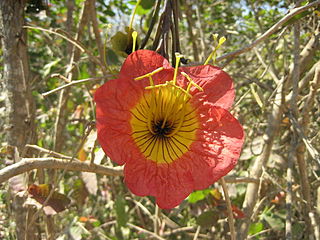
The Sapotaceae are a family of flowering plants belonging to the order Ericales. The family includes about 800 species of evergreen trees and shrubs in around 65 genera. Their distribution is pantropical.

Palaquium is a genus of about 120 species of trees in the family Sapotaceae. Their range is from India across Southeast Asia, Malesia, Papuasia, and Australasia, to the western Pacific Islands.

Manilkara is a genus of trees in the family Sapotaceae. They are widespread in tropical and semitropical locations, in Africa, Madagascar, Asia, Australia, and Latin America, as well as various islands in the Pacific and in the Caribbean. A close relative is the genus Pouteria.

Dombeya is a flowering plant genus. Traditionally included in the family Sterculiaceae, it is included in the expanded Malvaceae in the APG and most subsequent systematics. These plants are known by a number of vernacular names which sometimes, misleadingly, allude to the superficial similarity of flowering Dombeya to pears or hydrangeas. Therefore, the genus as a whole is often simply called dombeyas. The generic name commemorates Joseph Dombey (1742–1794), a French botanist and explorer in South America, involved in the notorious "Dombey affair", embroiling scientists and governments of France, Spain, and Britain for more than two years.

Eriolaena is a genus of flowering plants. Traditionally included in the family Sterculiaceae, it is included now in the recently expanded Malvaceae. The genus is distributed in Asia and eastern Africa, from southern China through Indochina to India, Bangladesh, Nepal, Sri Lanka, Madagascar, and coastal Mozambique.

Melhania is a genus of small shrubs or herbaceous plants. Traditionally included in the family Sterculiaceae, it is included in the expanded Malvaceae in the APG and most subsequent systematics. The genus is named for Mount Melhan in Yemen.

Nesogordonia is a genus of flowering plants. It ranges across tropical Africa, Madagascar, and the Comoro Islands. The majority of species are endemic to Madagascar.

Fernandoa is a genus of plants in the family Bignoniaceae.

Pyrostria is a genus of dioecious flowering plants in the family Rubiaceae. Most of the species are endemic to Madagascar, others occur on islands in the western Indian Ocean, a few are found in continental Africa, and only six species occur in tropical Southeast Asia. The formerly recognized genus Leroya, containing two species endemic to Madagascar, L. madagascariensis and L. richardiae, was sunk into synonymy with Pyrostria.

Vitellariopsis is a group of plants in the family Sapotaceae described as a genus in 1915. The genus is native to eastern and southern Africa.
- Vitellariopsis cuneata(Engl.) Aubrév. - Usambara Mts in Tanzania
- Vitellariopsis dispar(N.E.Br.) Aubrév. - Eswatini, KwaZulu-Natal
- Vitellariopsis ferrugineaKupicha - Zimbabwe
- Vitellariopsis kirkii(Baker) Dubard - Nampula, Tanzania, Kenya
- Vitellariopsis marginata(N.E.Br.) Aubrév. - Mozambique, Eswatini, South Africa

The Sapotoideae are a subfamily of the flowering plant family Sapotaceae. Plants in the subfamily are characterized by their leather-like leaves, often growing in a stipule fashion.

Planchonella is a genus of flowering trees in the gutta-percha family, Sapotaceae. Named in honour of Jules Émile Planchon, it was described by Jean Baptiste Louis Pierre. It contains around 110 mainly tropical species, which range from Pakistan through Southeast Asia and New Guinea to northern and eastern Australia, New Zealand, and the Pacific Islands. The genus is included in the larger genus Pouteria by some authorities, hence species such as Planchonella australis are also known as Pouteria australis.
Peponidium is a genus of flowering plants in the family Rubiaceae. The genus is endemic to Madagascar, except for Peponidium ovato-oblongum and Peponidium venulosum that are found on the Comoros, and Peponidium carinatum and Peponidium celastroides that are found on the Seychelles.
Danaideae is a tribe of flowering plants in the family Rubiaceae and contains 67 species in 3 genera. Its representatives are found in Tanzania and several islands in the western Indian Ocean: Comoros, Mauritius, Madagascar, and Réunion.
Planchonella reticulata is a flowering plant in the sapodilla family, Sapotaceae. It is a shrub or tree endemic to east-central New Caledonia. The specific epithet refers to the reticulate venation on the leaves.
Paul Louis Amans Dop was a French botanist who worked extensively in Indochina. From 1908 he was associated with the Mascarene botanist Marcel Marie Maurice Dubard, carrying out much taxonomic work under the name of Dubard & Dop.
Paracephaelis is a genus of flowering plants belonging to the family Rubiaceae.
Macarisia is a genus of flowering plants belonging to the family Rhizophoraceae.
Philgamia is a genus of flowering plants belonging to the family Malpighiaceae.











